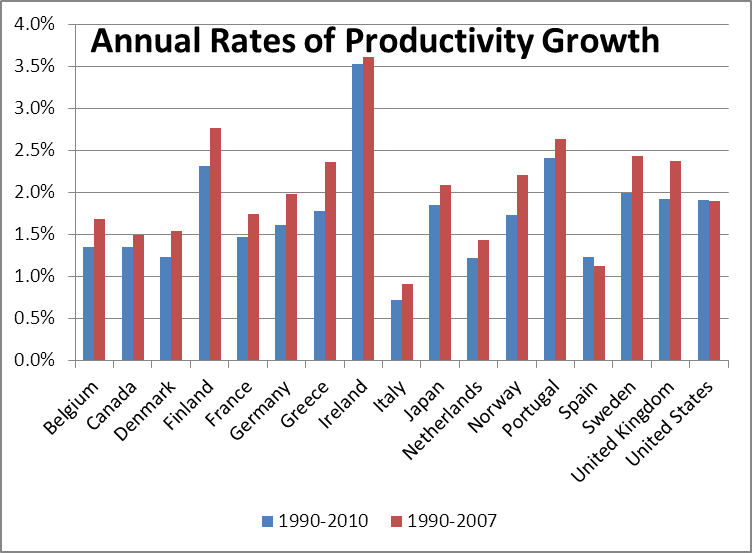Article • Dean Baker’s Beat the Press
Fact-based, data-driven research and analysis to advance democratic debate on vital issues shaping people’s lives.
Center for Economic and Policy Research
1611 Connecticut Ave. NW
Suite 400
Washington, DC 20009
Tel: 202-293-5380
Fax: 202-588-1356
https://cepr.net
Eamonn Fingleton started a debate on Japan’s slump or lack thereof with a Sunday review piece in the NYT. This has since been joined by Paul Krugman and others. Since I have been asked by a number of people what I thought, I will weigh in with my own two cents.
First I agree with Fingleton that the description of Japan as a basket case is way off the mark. While GDP growth has been weak, its productivity growth has been better than the average in the OECD.

Source: OECD.
The fact that its productivity growth has exceeded its GDP growth is explained by both the aging of the population, leading to a decline in the size of its labor force and also the reduction in the number of hours worked per year by the average worker. Neither of these seems to be obviously bad, although it is almost certainly the case that Japan still suffers from some hidden unemployment (mostly among women) in addition to its relatively low official unemployment (@ 4.0 percent).
Fingleton probably does go overboard in a few areas. First, Shadowstats is not a credible source. There are issues with the official statistics in the U.S. (as is the case everywhere), but the idea that we have overstated growth by 2 percentage points a year does not pass the laugh test.
Second, the measure of electricity use that he sees as a main determinant of living standards is likely distorted by the fact that Japan was starting from a very low base whereas the U.S. was starting from a very high base. We can get any number of new appliances that will be markedly better than the ones that they replaced and still use considerably less electricity. The same is not likely to be the case with Japan. The same applies to commercial and industrial users of electricity.
But there is an area in which Fingleton may actually understate his case. I remember refereeing a journal article at the end of the 90s about Japan’s price index for passenger trains. (Wait, this is not that boring.)
The article purported to show that the official Japanese index overstated inflation because it missed quality improvements. The main quality improvement was that the trains were less crowded. The author had compared the price of first class and second class seats and noted that the main difference between the two was that first class passengers were guaranteed a seat. However because the trains had become less crowded, almost everyone in second class could now get a seat as well. This in effect meant that a second class seat at the end of the period examined was as good as a first class seat at the beginning.
This made a substantial difference in the price index for trains, effectively showing a much slower rate of price increase when this quality improvement (less crowding) was taken into account. This issue could be an important factor in the quality of services across Japan more generally. If the reduced population has led to fewer people on planes and other forms of transportation, fewer people sharing parks and beaches and other potentially crowded public places, then it may imply a substantial improvement in living standards that would not be picked up in conventional economic measures.
I don’t know if anyone has researched this issue and tried to quantify the benefits that the Japanese may be receiving from reduced crowding, but it is plausible that the gains would be substantial.